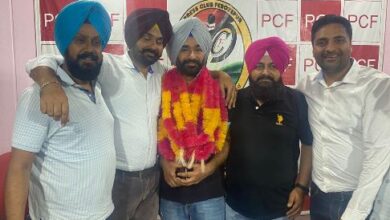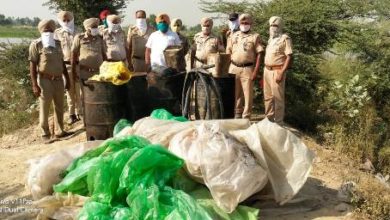Cellular Jail called Kala Pani – “A Living Hell” for revolutionaries who brought freedom to India
Personal experience of visiting the Port Blair Island in Andaman & Nicobar
Cellular Jail called Kala Pani – “A Living Hell” for revolutionaries who brought freedom to India
I had heard about Cellular Jail – Kala Pani – at Port Blair in Andaman Nicobar Islands, since my childhood but never thought that I could be visiting this place at the age of 66 years which now stands as a mute witness to the untold sufferings against the brutalities of the British barbarism.
What I feel is that the passion for freedom of India could be felt only after witnessing the ‘Light & Sound Programme’ based on the history of Cellular Jail in the evening followed by visit in the next morning. It takes you to the pre-independence days to have feeling of immense sacrifices of numerous Indians who valiantly fought for freedom.
The Kala Pani expression has been used with reference to the word ‘Kal’ means ‘Time or Death’. The term Kala Pani therefore meant the ‘water of death’ or ‘a place of death’ from where none returned. Kala Pani virtually means cruel and inhuman treatment for the rest of the life of the revolutionaries who have passion for the freedom of the country. In fact, a sentence of deportation to Kala Pani meant a warrant for throwing the freedom fighters in living hell to face unheard of trials and tribulations and to lead a life which was worse than the death penalty.
Cellular Jail – also known as notorious Cellular Jail of Port Blair, Andaman Nicobar Islands with the solitary cells 13.6 x 7.6 feet, torture chambers and other such structures recount the story of many Indians who fearlessly fought against the British rule. In all, the Cellular Jail had 698 cells.
It has seven wings, each departing towards different directions from a central tower and each wing had three storeys. Presently, four of the seven wings of this “starfish-like structure” have since been pulled down – two by the Japanese and two have been made way for the G.B.Pant Hospital leaving only three wings 1, 2 and 7 are preserved. Each wing was so wisely designed to minimize the chance of dialogue among the prisoners and to isolate them from each other, the front portion of each wing was made to face the rear of the other. However, each cell has a ventilator in the back wall at an inaccessible height and built in a manner that made any contact with others impossible.
The Cellular Jail is a massive brick and mortar structure resembling a great fort. In colonial times, it symbolized the authority of the rulers and their designs to crush Indian resistance as also the dauntless spirit of those who challenged the British Empire.
In fact, it was the British policy that a prison regime must be punitive and humiliating, even more dreadful than the hangman’s noose. Before the construction of the Cellular Jail, the prisoners used to be housed in barracks in Port Blair. The resistance always invited punished with fetters, chain fetters, bar fetters and cross bar fetters.
The construction of the Cellular Jail began in 1896 and by 1987 about 400 cells of the jail were read for occupation. It was fully completed in 1906 at a cost of Rs.5,17,352. This unique structure symbolized the authority of the colonial rulers and their design to crush the political protests of the enslaved country.
Though every revolutionary have its own role in bringing the freedom to India and there is a long list of prisoners at the Cellular Jail. The prominent among the 75 prisoners’ from Punjab was one Mahabir Singh – an associate of Shaheed Bhagat Singh.
The story of Mahabir Singh goes like this – the condition of some of the prisoners who were on the hunger strike soon began deteriorating and it became a cause of concern to the authorities who decided to start the process of force –feeding. But such was the determination of the prisoners that they resolved to resist force-feeding so that they may die, thereby paving the way to victory.
But Mahabir attained martyrdom before he could be shifted to the hospital. The jail administration however, concealed the facts and sent a report to the Government of Punjab stating that the cause of death of Mahabir Singh as ‘due to shock’.
Despite torture and the humiliation, these prisoners had the spirit of versification.
He was a poet and in his words – “I have seen the invitation of death at my door; who struck first by stepping with the atrocities; it also today closed my luck door; but say, who got freedom without sacrifices”.
Another well-known revolutionary was Vinayak Damodar Savarkar who was arrested in London in 1910 for offence of waging war against the King Emperor and was deported to India abroad the ship S.S.Morea but he escaped through the pot-hole into the sea and ran three meters into the French Territory. He was soon caught by the French police which handed him back to the British police. He was punished for life imprisonment during trial in Bombay now Mumbai on December 23, 1910 besides for the murder of Jackson Collector of Nasik. In this case also, he was convicted and ssentenced to transportation for life on Jan. 30, 1911 and brought to Andamans with the badge of 50 years sentence around his neck. He was repatriated in 1921 after staying in the Cellular Jail for ten years.
The jail was declared as a National Memorial on February 11, 1979 and it was dedicated to the nation by then Prime Minister Morarji Desai, in the presence of number of revolutionaries who had been incarcerated in this jail during the colonial period.
K.R.Narayanan, former President of India has rightly said, “If we can transmit to the generation, the patriotism of the Anadaman freedom fighters… their courage, their capacity for sacrifice, then we would have done something significant today”.
Frankly speaking, a narration by the Guide, on my visit to this place, Mustafa – compelled the inner conscious to undergo to feel the physical, mental and psychological humiliation inside the jail.
Really, it is a real centre of research for understanding the contribution of the patriots to freedom struggle and the courage and fortitude of the revolutionaries could be only felt by visiting this place.
Our young generations, who have born after the independence of India could be put them wiser only if such stories are made a part of the syllabus.
On seeing the long list of comments by the visitors in the book, I too could not resist myself from recording – “Really after the visit to Cellular Jail, one can have feeling of freedom of India – how costly it was ? Hats off! to martyrs and prisoners of that time”.






